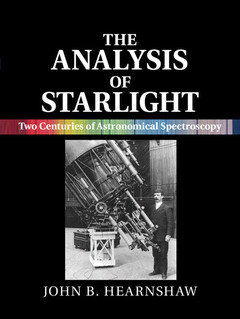Description
The Analysis of Starlight (2nd Ed.)
Two Centuries of Astronomical Spectroscopy
Author: Hearnshaw John B.
A reference for astronomers and historians on astronomical spectroscopy, from the discovery of spectral lines through to the year 2000.
Language: English
Approximative price 159.02 €
In Print (Delivery period: 14 days).
Add to cart
Publication date: 03-2014
382 p. · 20.7x26 cm · Hardback
382 p. · 20.7x26 cm · Hardback
Description
/li>Contents
/li>Biography
/li>
First published in 1986, this is the story of the analysis of starlight by astronomical spectroscopy. Beginning with Joseph Fraunhofer's discovery of spectral lines in the early nineteenth century, this new edition continues the story through to the year 2000. In addition to the key discoveries, it presents the cultural and social history of stellar astrophysics by introducing the leading astronomers and their struggles, triumphs and disagreements. Basic concepts in spectroscopy and spectral analysis are included, so both observational and theoretical aspects are described, in a non-mathematical framework. This new edition covers the final decades of the twentieth century, with its major advances in stellar astrophysics: the discovery of extrasolar planets, new classes of stars and the observation of the ultraviolet spectra of stars from satellites. The in-depth coverage makes it essential reading for graduate students working in stellar spectroscopy, professional and amateur astronomers, and historians of science.
Preface to the first edition, 1986; Preface to the second edition; Acknowledgments for the first edition; Acknowledgments for the second edition; 1. Introduction to spectroscopy, spectroscopes and spectrographs; 2. The analysis of sunlight: the earliest pioneers; 3. The foundations of special analysis: from Fraunhofer to Kirchhoff; 4. Early pioneers in stellar spectroscopy; 5. Spectral classification at Harvard; 6. The doppler effect; 7. The interpretation of stellar spectra and the birth of astrophysics; 8. Spectral classification: from the Henry Draper catalogue to the MK-system and beyond; 9. Spectroscopy of peculiar stars; 10. Quantitative analysis of stellar spectra; 11. Some miscellaneous topics in stellar spectroscopy: individual stars of note, stellar chromospheres, interstellar lines and ultraviolet spectroscopy from space; Appendix A. List of solar lines designated by letters by Fraunhofer and others; Appendix B. Vogel's first spectral classification scheme of 1874; Indexes.
John Hearnshaw is Professor of Astronomy at the University of Canterbury, Christchurch, New Zealand. His research interests span stellar astrophysics, astronomical spectrographs, and the historical development of astrophysics. He is a Fellow of Royal Society of New Zealand, a member of the International Astronomical Union (IAU), and a Foreign Associate of the Royal Astronomical Society of London. Professor Hearnshaw is the author of four books and 200 papers in astronomical literature, and has served as editor for seven conference proceedings. He has held visiting positions at Astrophysikalisches Institut Potsdam, Nagoya University, and National University of Mongolia, Ulaan Baatar. He has also served as Chair of IAU Program Group for the Worldwide Development of Astronomy, with lecture tours to Mongolia, Cuba, Thailand, Laos, Vietnam, Mauritius, Trinidad and Tobago, Venezuela, Paraguay, Uzbekistan, Tajikistan, Fiji and North Korea.
© 2024 LAVOISIER S.A.S.
These books may interest you

Asteroseismology 112.80 €



